
St Peter's Cathedral is a Roman Catholic church and former cathedral in Worms, southern Germany.

Limburg Cathedral (German: Limburger Dom, also known as Georgsdom after its dedication to Saint George, is located above the old town of Limburg in Hesse, Germany. It is the cathedral of the Catholic Diocese of Limburg. Its high location on a rock above the river Lahn provides its visibility from far away. It is the result of an Early Gothic modernization of an originally Early Romanesque building and therefore shows a Romanesque-Gothic transitional style.
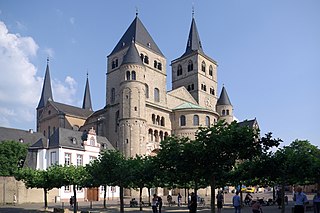
The High Cathedral of Saint Peter in Trier, or Trier Cathedral, is a Roman Catholic cathedral in Trier, Rhineland-Palatinate, Germany. It is the oldest church in Germany and the largest religious structure in Trier, notable for its long life span and grand design. The central part of the nave was built of Roman brick in the early fourth century, resulting in a cathedral that was added onto gradually in different eras. The imposing Romanesque westwork, with four towers and an additional apse, has been copied repeatedly. The Trier Cathedral Treasury contains an important collection of Christian art. In 1986 the church was listed as a UNESCO World Heritage Site, as part of the Roman Monuments, Cathedral of St. Peter and Church of Our Lady in Trier.
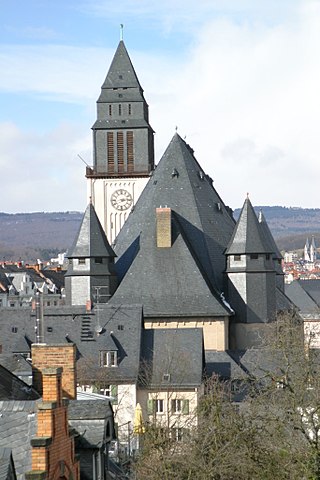
The Lutherkirche is one of four main Protestant churches in Wiesbaden, the capital of Hesse, Germany. It was built between 1908 and 1910 in Jugendstil and in accordance with the Wiesbadener Programm, to a design by Friedrich Pützer. With two organs and good acoustics, it is also a concert venue.

St. Martin is the name of a Catholic parish and church in Idstein, Rheingau-Taunus-Kreis, Germany. The official name of the church is Katholische Pfarrkirche St. Martin. The name of the parish became St. Martin Idsteiner Land on 1 January 2017, when it was merged with five other parishes. The parish is part of the Diocese of Limburg.
Liebfrauenkirche is a common dedication for churches in German-speaking countries.

Rheingauer Dom is the colloquial name for the Catholic parish church in Geisenheim, Germany. Officially Pfarrkirche Heilig Kreuz, the large church in the Rheingau region is called Dom although it was never a bishop's seat. The present building was begun in the 16th century, but major features such as an expansion of the nave from three to five vaults, the towers, the organ and several altars were added in the 19th century. The parish is part of the Diocese of Limburg.
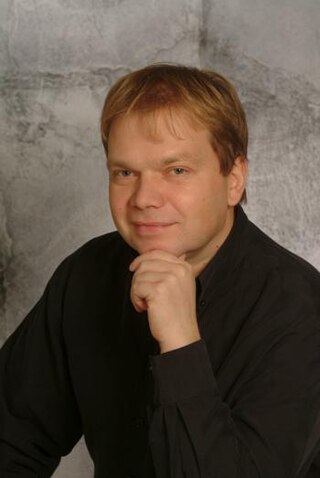
Andreas Boltz is a German church musician and composer. From autumn 1993 until 2011, he was the Regional Cantor of the diocese of Mainz in Darmstadt. He was awarded the Premio Speciale in 1992 at the International Composers Competition in Trieste. Since June 2011, he has been cathedral music director at the Frankfurt Cathedral.

The Church of Our Lady is an Evangelical Protestant church situated northwest of the Market Square in Bremen, Germany. Like Bremen Cathedral, today's building dates from the 13th century. The brightly coloured stained-glass windows are the work of the French artist Alfred Manessier. In 1973, the church was listed under the monument protection act.
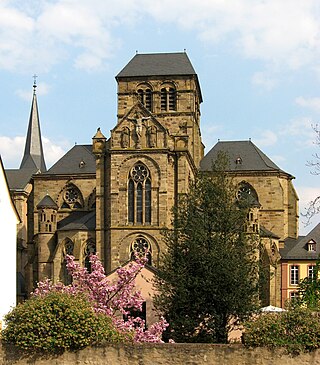
The Liebfrauenkirche in Trier, is, according to UNESCO, "the earliest church built in French High Gothic style outside France." It is designated as part of the Roman Monuments, Cathedral of St Peter and Church of Our Lady in Trier UNESCO World Heritage Site. The Trier Dom (cathedral) is next to it, and the two buildings share a common wall.

St. Valentin is the common name for the Catholic parish church and Basilica minor Basilica of SS Dionysius and Valentinus in Kiedrich in the Rheingau, in Hesse, Germany. It was built at the end of the 15th century in the Gothic style. Its organ is one of the oldest playable organs in Germany. The church was a pilgrimage destination for people with epilepsy and therefore has notable carved wooden laity stalls, including one decorated with the "Gerechtigkeitsspirale".

Kloster Engelberg is a Franciscan monastery in Grossheubach in Bavaria, Germany. In the past, a pilgrimage dedicated to a figure of Mary, documented as far back as 1406, was administered by the Capuchins after 1630. Following secularization in the early 19th century, the Capuchins eventually left and the Franciscan order took over the abbey and caring for the pilgrims. The abbey is (partially) open to the public.
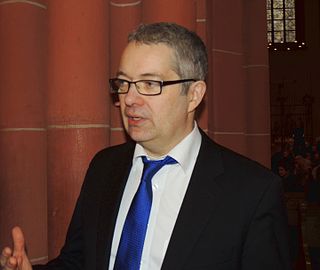
Peter Reulein is a German composer, organ improviser, academic teacher and church musician, from 2000 at the church Liebfrauen in Frankfurt am Main. In 2016 he composed for the Catholic Diocese of Limburg the Franciscan oratorio Laudato si'.

Eugen Eckert is a German social worker, minister, singer-songwriter and academic teacher. He is known for his lyrics for new spiritual songs, and his oratorios and musical plays.

Laudato si' is an oratorio composed in 2016 by Peter Reulein on a libretto by Helmut Schlegel. Subtitled Ein franziskanisches Magnificat, it includes the full Latin text of the Magnificat, expanded by writings of Clare of Assisi, Francis of Assisi and Pope Francis. The composer set it for five soloists, children's choir, Choralschola, mixed choir, symphony orchestra and organ. It was published in 2016 by the Dehm Verlag, and was premiered on 6 November 2016 at the Limburg Cathedral, conducted by the composer.
Andreas Großmann is a German organist, church musician and conductor. He is the head of the Referat Kirchenmusik in the Diocese of Limburg, responsible for its church music.
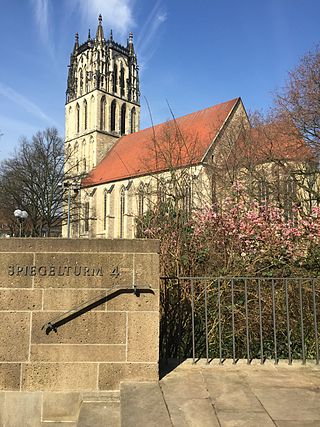
Überwasserkirche is the common name of a Gothic hall church in Münster, North Rhine-Westphalia, Germany. It is a Liebfrauenkirche, dedicated to St. Mary. Officially St. Marien Überwasser, it is also called Liebfrauen-Überwasser. The name literally means "church beyond the water" and describes the location as on the other side of the Aa river, looking from the Münster Cathedral. It was inaugurated as part of an educational Stift in 1040, which later became the University of Münster.

St. Martin is a Gothic church and the associated Catholic parish in Lorch am Rhein, Hesse, Germany. In 2002, it became part of the Rhine Gorge, a UNESCO World Heritage Site. The church features the oldest and largest monochrome wood-carved altar in Germany. Its organ from 1984 makes it also a concert venue, where international organists such as Olivier Latry have performed.

St. Gallus is a Catholic church and parish in Flörsheim, Hesse, Germany, dedicated to Saint Gall. It was completed in 1766 in Rococo style. Featuring a historic organ from 1709, it is a concert venue of the Gallus-Konzerte series of mostly sacred music concerts.

The Liebfrauenkirche in the Thuringian town of Arnstadt, Germany, is a Lutheran parish church. The basilica, which was essentially erected in the 12th and 13th centuries, is considered, along with Naumburg Cathedral, to be the most important church building of the transitional phase from Romanesque to Gothic architecture in Thuringia.






















